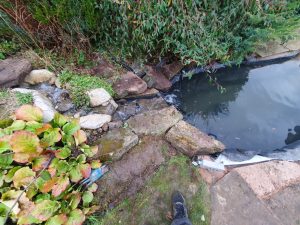Today we visited a tired looking pond which was in need of some TLC! The current pond liner that was installed was made from PVC, although this is a cheaper option compared to a rubber pond liner, it does have its downfalls. The PVC liners are more prone to being punctured and becoming brittle in the suns UV rays. Sadly, for the customer their PVC liner had torn as it had become brittle around the edges of the pond.
What pond liner and pond filter we chose
After a discussion with the client, it was clear that they wanted a pond liner which was going to last. There’s nothing more frustrating than spending time installing a liner for it to only spring a leak. Due to this we agreed to install a 1mm Firestone rubber pond liner. This liner is the thickest available, so it’s much less likely to puncture. With this liner being made from high quality rubber it’s a lot more flexible and easier to manoeuvre, making it an ideal choice. A good quality underlay is always recommended so we used a 200gsm fleece, which is classed as heavy duty.
The customer at this point did not have any filtration in the pond, just a filter pump that pumped water up to a waterfall. A filter is always recommended even if it’s just a wildlife pond. We chose to install the Hozelock Revolution 6000, this is a pressure filter designed to handle ponds with fish at 6000ltr. A matching pump of 7500lph was added to give a better flow in the pond, as the filter was 1.5 meter above the water level, this was the ideal choice. The Hozelock Revolution 6000 was chosen because of its easy cleaning function, it takes 2 minutes to clean without having to remove the internal media.
How we replaced the old pond liner for new
Firstly, we had to remove the old dirty water from the pond, along with any fish and wildlife. This pond was teaming with wildlife, every nook and cranny there was a frog hiding! All the livestock and plants were removed into the large temporary holding vat until the work was completed. We pumped out all the dirty water and sludge from the pond using specialist vacuums and pond equipment. Now that the pond was empty, we simply cut out the old PVC liner and underlay. The heavy-duty underlay was pinned into the side so there was no movement when it came to installing the liner.
We removed the liner from the retail packaging and opened this up on a snag free surface. We then folded the liner from corner to corner so that when we dropped this in the pond all we had to do was unfold it. When the liner was in, we pulled the liner tight to the edges inside to remove creases and tided the folds. Once this was done, we started filling the pond with de-chlorinated water, again pulling out any creases that appeared.
The finishing touches!
To get the liner in we had to remove the Indian Stone that was positioned around the edge of the pond. These were carefully re-paved ensuring we added the pointing colourant so that it matched what was already laid. We also re-laid the bottom part of the waterfall ensuring this looked seamless and of course water tight! Now the new pond liner was in, the filter / pump installed and the waterfall fixed from any leaks. We would now re-introduce the newly potted plants and the livestock. The fish and frogs were slowly acclimatized, so they could enjoy their newly cleaned pond.








